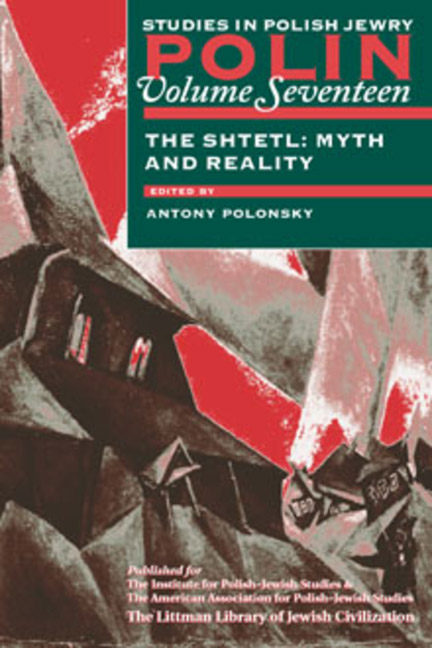Book contents
- Frontmatter
- Dedication
- Editors and Advisers
- Preface
- Polin
- Polin: Studies inPolish Jewry
- Contents
- Note on Place Names
- Note on Transliteration
- List of Abbreviations
- PART I THE SHTETL: MYTH AND REALITY
- Introduction. The Shtetl: Myth and Reality
- The Shtetl as an Arena for Polish–Jewish Integration in the Eighteenth Century
- Inter-Religious Contacts in the Shtetl: Proposals for Future Research
- The Hasidic Conquest of Small-Town Central Poland, 1754–1818
- The Drama of Berdichev: Levi Yitshak and his Town
- Polish Shtetls under Russian Rule, 1772–1914
- How Jewish Was the Shtetl?
- The Changing Shtetl in the Kingdom of Poland during the First World War
- The Shtetl: Cultural Evolution in Small Jewish Towns
- Small Towns in Inter-War Poland
- Jewish Patrons and Polish Clients: Patronage in a Small Galician Town
- Maintaining Borders, Crossing Borders: Social Relationships in the Shtetl
- The Soviet Shtetl in the 1920s
- Shtetl and Shtot in Yiddish Haskalah Drama
- Kazimierz on the Vistula: Polish Literary Portrayals of the Shtetl
- Imagining the Image: Interpretations of the Shtetl in Yiddish Literary Criticism
- Shtetl Codes: Fantasy in the Fiction of Asch, Schulz, and I. B. Singer
- Returning to the Shtetl: Differing Perceptions
- PART II NEW VIEWS
- PART III DOCUMENTS
- PART IV THE SIXTY-FIFTH ANNIVERSARY OF EVENTS IN PRZYTYK: A DEBATE
- PART V REVIEWS
- OBITUARIES
- Notes on the Contributors
- Glossary
- Index
The Soviet Shtetl in the 1920s
from PART I - THE SHTETL: MYTH AND REALITY
- Frontmatter
- Dedication
- Editors and Advisers
- Preface
- Polin
- Polin: Studies inPolish Jewry
- Contents
- Note on Place Names
- Note on Transliteration
- List of Abbreviations
- PART I THE SHTETL: MYTH AND REALITY
- Introduction. The Shtetl: Myth and Reality
- The Shtetl as an Arena for Polish–Jewish Integration in the Eighteenth Century
- Inter-Religious Contacts in the Shtetl: Proposals for Future Research
- The Hasidic Conquest of Small-Town Central Poland, 1754–1818
- The Drama of Berdichev: Levi Yitshak and his Town
- Polish Shtetls under Russian Rule, 1772–1914
- How Jewish Was the Shtetl?
- The Changing Shtetl in the Kingdom of Poland during the First World War
- The Shtetl: Cultural Evolution in Small Jewish Towns
- Small Towns in Inter-War Poland
- Jewish Patrons and Polish Clients: Patronage in a Small Galician Town
- Maintaining Borders, Crossing Borders: Social Relationships in the Shtetl
- The Soviet Shtetl in the 1920s
- Shtetl and Shtot in Yiddish Haskalah Drama
- Kazimierz on the Vistula: Polish Literary Portrayals of the Shtetl
- Imagining the Image: Interpretations of the Shtetl in Yiddish Literary Criticism
- Shtetl Codes: Fantasy in the Fiction of Asch, Schulz, and I. B. Singer
- Returning to the Shtetl: Differing Perceptions
- PART II NEW VIEWS
- PART III DOCUMENTS
- PART IV THE SIXTY-FIFTH ANNIVERSARY OF EVENTS IN PRZYTYK: A DEBATE
- PART V REVIEWS
- OBITUARIES
- Notes on the Contributors
- Glossary
- Index
Summary
THE REVOLUTION WRITES OFF THE SHTETL
BOLSHEVIK apparatchiks, most notably functionaries of the Evsektsii (Jewish sections of the Communist Party), began to deal seriously with the shtetl only in 1920–1, after the civil war. In the previous post-revolutionary years, when the shtetl was bleeding under the yoke of various armies and gangs, the Soviet apparatus was cut off from the bulk of the Jewish population. During the course of the civil war there were 1,520 pogroms; perhaps 200,000 Jews were killed, about 1 million became refugees; and 300,000 Jewish children were orphaned; one-third of all Jewish property was destroyed. In the words of the Soviet anthropologist Vladimir Tan-Bogoraz, the Jews ‘endured the revolution rather than making it’; they ‘paid more for the revolution and got less than other peoples’ of Russia. The Central Bureau of the Evsektsii reported in 1922 and 1923 that in Ukraine, the epicentre of anti-Jewish atrocities, the victims of the pogroms numbered 600,000, including 150,000 killed and 200,000 injured. In the provinces (guberniyas) of Odessa and Nikolaev 40 per cent of all skilled Jewish clothing-industry workers died of starvation. The decrease in the Soviet Jewish population in the Soviet territories as a result of the First World War, the civil war, pogroms, and emigration has been estimated at 500,000.
The shtetl Jews’ enthusiasm for the revolution was thus undoubtedly apocryphal; it was perhaps a canard of the counter-revolutionary propaganda that equated Jewish Bolsheviks—a tiny minority of the Jewish population—with the masses of ordinary shtetl inhabitants. Indeed, it is difficult to imagine how the new regime, with its anti-religious slogans and expropriations, could appeal to an ordinary Jewish householder. This is not to say that no one in the shtetls supported the Bolsheviks; local supporters were usually recruited from among young people, who staffed the local Soviet institutions and were active in the requisitions that became an integral part of early Soviet Jewish life. Also, many shtetl-dwellers who had suffered at the hands of the counter-revolutionary army saw the Bolsheviks as the lesser of two evils. Although the Red Army also sometimes carried out pogroms, the main perpetrators were recent defectors from the Ukrainian or White armies. The Soviet command quickly took demoralized units in hand.
- Type
- Chapter
- Information
- The Shtetl: Myth and Reality , pp. 197 - 212Publisher: Liverpool University PressPrint publication year: 2004

